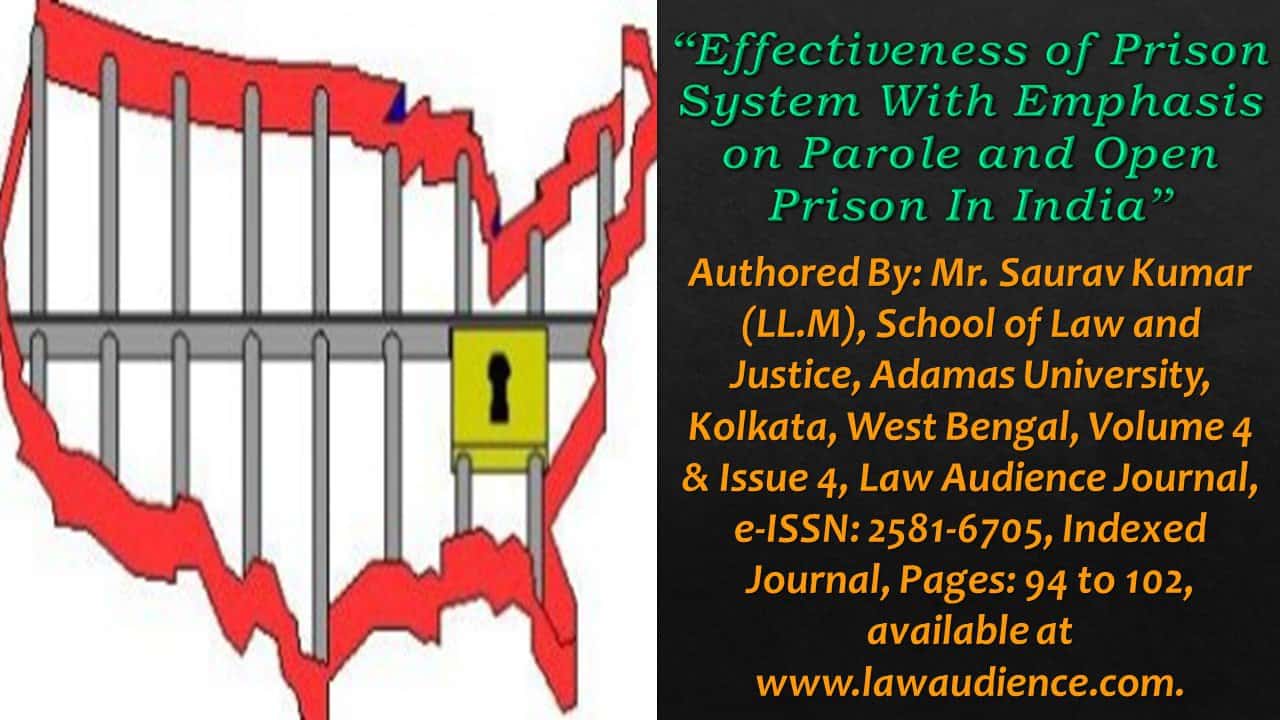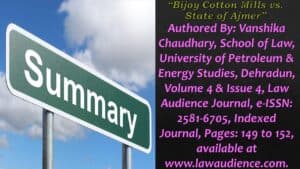Click here to download the full paper (PDF)
Authored By: Mr. Saurav Kumar (LL.M), School of Law and Justice, Adamas University, Kolkata, West Bengal,
Click here for Copyright Policy.
ABSTRACT:
“Prison this word has often been associated with prisoners who are sent to incarceration for their reformation and as a result bring back into the mainstream of society. Also, the various theories of punishment which is adjudged to bring them to the real world and for their betterment in the form of Reformatory theory which is prevalent in India. From the Vedas to the Marathas, we will see how they used different forms of punishment to reform such as mutilation, flogging, branding and Tazir, hadd, as the treatment so that they be brought back to normal life. Thereafter with British rule we see the prison system being established and also certain Reform Committees who took action for long periods of incarceration and introduced the concept of open prison and parole.
Also, how the prisoners are being treated as mere animal existence and not human which was adjudged by Krishna Iyer in Inder Singh vs. Delhi Administration[1], and thereafter the change in the mindset which is brought through. We will also see the various benefits of open jails which it provides in form of wages, liberal bank loans, minimum security, an opportunity to upskill themselves for the future endeavours and discipline their lives and also to socialise with the inmates which they couldn’t had they been in proximity with hardened criminals. And as a result, we also see the repercussions we are facing with the introduction of open prisons being the responsibility of officials who become a pawn in the hands of criminals and give up their authority which disrupts the process of reformation”.
Keywords: Prison, Punishment, Incarceration, Parole, Open Prison.
I. PRISON:
Britannica Encyclopedia says that persons convicted of felonies or major crimes confined in an institution is referred to as prison[2]. A place where prisoners are kept in such a way that there is not as much physical movement from the walls of the building and also there is refusal as to not do acts punishable under state power[3]. In common understanding it can be said that a prison is a place wherein the person who has committed a certain offence and has been given punishment by the competent court is kept for the term of his sentence. Prisons Act 1894, Section 8, states that under the special orders of Government of State detention of prisoners any temporary or permanently used place which is building or land attached for the purpose of being used as a jail is a prison. But place for prisoners’ confinement in police custody and under Code of Criminal Procedure 1882 Section 541, especially a place appointed by Government of State and also a subsidiary jail declared by Government of State through general or special order are not included[4].
II. THEORIES OF PUNISHMENT:
There are basically five types of Punishment such as:
- Deterrent Theory
- Reformative Theory
- Retributive Theory
- Preventive Theory
- Expiatory Theory
The major portion of life a prisoner has to go through in a prison is to make him better for the society as a whole. But it turns out inside the prison the criminal getting in turn with hardened criminals become much more towards the same path. The Theory Of Reformation helps the prisoner as he goes through certain activities like cultural, open prisons and parole has evolved as a result.
III. HISTORICAL EVOLUTION:
III.I ANCIENT:
Certain principles as to punishment were enumerated through Manu and Yajnavalkaya and also Dharmashutras and shastras represent judiciary in its well-developed form. The law during those times was based upon Shrutis and Smritis. There was inclusion of sutras and shastras in the Smritis making it religious and enforced only by the approval of the society[5]. Dharmashastras didn’t treat castes alike wherein Brahmins had the highest advantage with regard to punishment and Sudras lowest.
Punishment consisted of:
- Death
- Mutilation
- Banishment
- Branding, etc
During the reign of Mughal period their main source was Quran as a law which they used to follow. As per the jurisprudence of Muslim law crimes were segregated into groups of three being offences against God, State offences and private property offences and punishments such as hadd, i.e., right of God, tazir i.e., to reform the culprit and it can be in any of the type such as reprimand to public, offenders being dragged on the floor, exile, etc. It included rank and title forfeiture, humiliations, whipping, etc[6]. During Maratha period there was also no provision of imprisonment as such. There were three punishments mainly Diwan Danda i.e., royal form of punishing in which separate department was there of State who administered it for keeping peace and Deva Danda and Jati Danda were social and religious form. Some rooms were in forts named as Bandikhanas or Adabkhanas for offenders of serious crimes and were under the watchful eyes of Subedar who freed them based on the order from Peshwa.
Prisoners were subjected to treatment as per their seriousness of crime and status in society. Sometimes they were released on emergency based on emergency which gives us a glimpse of parole[7]. The rule of British made certain changes towards constitution of prison. The Indian Government established Committee for Prison Enquiry in 1836, wherein practice of operating prison inmates on road infrastructure was abolished. The Second Committee of Prison Enquiry constituted in 1862 for investigating the degrading conditions of jails. There was improvement in facilities such as health in 1866 and to make women protection from disease certain amenities were given. In 1894 Prison Act was enacted to provide uniformity in prison system of India[8]. In 1877 the issue of employing prisoners on sites such as digging, mining was put into question which was accepted[9]. The need for humane treatment of offenders was put forward again by Chairman of Committee for All India Jail Sir Alexander Cardew in 1919-20. His contention being most important part of life of convict is when he comes out of prison so having fear and lost his character making him unable to cope with daily life of the society. Though suggestion was also made as to agricultural farm employment of prisoners but it involved a larger area and proper supervision for want of which it was dropped[10]. The 1949 Pakwasa Committee constituted after Independence suggested utilisation of prisoners for road work without any supervision. The 1960 Manual of Model Prison made recommendation as to treatment of offenders and certain principles were laid out. The 1987 Committee of Justice Krishna Iyer recommended inclusion of more women to deal with the special role of treatment of women and child perpetrators[11].
IV. RECENT DEVELOPMENTS:
IV.I EDUCATIONAL PROGRAM:
In Assam in certain jails there has been the concept of open distance learning. The prisoners are provided education in the jail through National Institute of Open Schooling (NIOS), Bihar Board of Open Schooling and Examination (BBOSE), Nalanda Open University (NOU) and IGNOU in the State of Bihar. In Gujarat Dr Babasaheb Ambedkar Open University provides education and also anganwadis for the innocent children residing with their mothers. Special Study Centres of IGNOU has been established in Jammu and Kashmir[12].
IV.II HEALTH PROGRAM[13]:
IV.II.I BIHAR:
- Mandatory screening of health of all new admitted prisoners.
- Inmates are provided medical amenities.
- Awareness programmes organised by Government hospitals.
IV.II.II JAMMU AND KASHMIR:
Para medical staff and Doctors look after prisoners and provide treatment in jails. Adequate cleaning cloth and sufficient water for drinking are provided.
IV.II.III HIMACHAL PRADESH:
AIDS awareness camps in collaboration with local hospitals for jails.
IV.II.IV NAGALAND:
Mini health clinic in collaboration with Foundation for Community Awareness Development (CAD).
IV.III YOGA AND MEDITATION[14]:
IV.III.I ASSAM:
Training is imparted in jails.
IV.III.II BIHAR:
In all jails it is conducted.
IV.III.III MAHARASHTRA:
“YOGA” an awareness program for mental and physical well-being of inmates is organised.
IV.III.IV UTTAR PRADESH:
Institute of Aghor Peeth Sarveshwari Group imparts to detained prisoners.
IV.IV VOCATIONAL TRAINING IN PROFESSION[15]:
IV.IV.I ASSAM:
Educational training, Computer literacy being provided for their rehabilitation.
IV.IV.II BIHAR:
- Training of prisoners in different RSETI (Rural Self Employment Training Institute)
- Prison industry such as industrial units for bakery, soap making, phenyl making, tent making, etc.
IV.IV.III GUJARAT:
Training for employment in industries such as Bakery, cattle feeding, carpentry, weaving, tailoring, Dairy products, embroidery, ornamental wooden products, etc. Also, different programmes such as polishing diamond, making toy, recording voice, repairing motor cycle, snacks making, etc.
IV.IV.IV HIMACHAL PRADESH:
Skill based training with aid of Umang NGO and RSETI Dharamshala.
IV.IV.V JAMMU AND KASHMIR:
Making candles, Bamboo art, Cutting hair, Making furniture, etc.
IV.IV.VI KARNATAKA:
Power looms, Handlooms. Making footwear, Training in bakery preparation, Refurbishing Wheel Chair, Fabric Painting, etc.
IV.IV.VII NAGALAND:
Candle stand, Cultivating winter crops to achieve basic needs of kitchen, Detergent making training, Training in Culinary.
V. PAROLE:
Parole System in the Indian subcontinent is governed by rules under the Prison Act,1894[16] and Prisoners Act,1900[17] . Every State has its own rules regarding it with some slight variation.
V.I ELIGIBILITY:
According to the Guidelines of 2010 Parole/Furlough[18] , to be eligible for parole:
- A convict must have served at least one year in jail, excluding any time spent in remission.
- The prisoner’s behaviour had to be uniformly good.
- The criminal should not have committed any crimes during the period of parole if it was granted previously.
- The convict should not have broken any of the terms and restrictions of his or her previous release.
- A minimum of six months should have passed since the previous parole was terminated.
In Dharambir And Another vs. State Of U.P[19], It was directed by the Apex Court that such prisoners who are serving long time in jail be given two weeks once a year throughout their period of imprisonment.
In Krishanlal vs. State of Delhi[20], the apex court did not accept the contention of economic necessity for reducing the sentence in forgery case but did allow parole at reasonable spells of time.
In Inder Singh vs. Delhi Admnistration[21], It was held that there happens to a certain distress in the minds of two young men when they are sent into incarceration for such long period. The case highlights the humanistic aspect of the plight in which the man committed the act of murder and also the mind which will become when he will be put behind bars. It is an established fact that he has committed the act in a fit of rage or being pushed into it by some feud in the family but that itself cannot make him much more criminalised by a long prison life and as such they must be redeemed in the society. As such in this nation everyone has a background and thereby a future which can be provided given a better rehabilitative approach in prison. The dharma danda neeti as well as the order of constitution is to seek human dignity and social justice and not the hard confinement for years. It has been said by the Supreme Court of California that there is no place for vengeance and retribution when a person is being put into punishment for the main purpose is to reform him to make him lead a better life and become a much more sophisticated person. In a District Court of U.S. in 1971 in Maryland there was the missing of rehabilitation aspect in the system of prison which was ordered to be accelerated by the Court. As such a man cannot be treated with disrespect and brutality for, he did commit a crime but he is still a human being and the reason being most keepers are disrespected by the inmates is they do not give proper respect to the inmates like human beings. So as a result, if a man is treated like animal, he will become one and the same how can we expect him to become a human being.
In Gurdeep Bagga vs. Delhi Administration[22], the petitioner was granted annual leave by the apex court as a lenient view to unite the family but was not granted parole by the High Court as he was on parole for two years and he has two sisters to look after his ailing mother.
VI. OPEN PRISON:
Section 2 clause a of The Rajasthan Prisoners Open Air Camp Rules define open jail as, place which is declared for the detention of prisoners to be Open Air Camp i.e., to say in simple words “Prisons without walls, bars and locks.”[23]. The Jail Committee of 1956-57[24], which was constituted after Technical Expert of U.N. Walter Reckless submitted Report concerning the administration of prison in India and the open jail for prisoners was recommended for rehabilitation of prisoners.
Certain characteristics are as follows[25]:
- Informal and institutional living in groups which is small with minimum custody.
- Promotes consciousness among inmates of their responsibility towards society.
- Adequate facilities in inmate training for agriculture and other occupations.
- Liberal remissions are allowed to an extent of fifteen days in a month.
- It is managed by well trained personnel.
- Proper attention is being attended as to towards health and facilities related to recreation among inmates.
- Ensures payment of wages and also a part of it is being sent to his family.
- Also, special diet for weak inmates.
- Financial assistance is being provided through liberal bank loans.
- Free and intimate contact between staff and inmates.
There has been establishment of Open Prison in Yerwada Jail wherein prisoners who work in it and do farming without any supervision and are paid for it. Also, there was establishment in Durgapur Rajasthan where long termers such as serving 6 to 8 years were put in prison without supervision.
VII. CONCLUDING REMARKS:
We have come a long way from the ancient forms of punishing a person which was under the eye of God or through the texts such as Manu for the offences committed by the offender. With the advent of British rule, it changed into prison cells by which they were sent there to long periods of incarceration with no future after return to society.
With the changing dynamics of society there was introduction of parole and open prison which though serves its purpose but it is often seen that parole is much better as the prisoner is sent to unite with his family and as a result reform whereas in open prison, they sometimes control the prison officials and become the head and dictate their own terms which is seen as a waste of public exchequer.
Cite this article as:
Mr. Saurav Kumar, “Effectiveness of Prison System With Emphasis on Parole and Open Prison In India”, Vol.4 & Issue 4, Law Audience Journal (e-ISSN: 2581-6705), Pages 94 to 102 (1st November 2022), available at https://www.lawaudience.com/effectiveness-of-prison-system-with-emphasis-on-parole-and-open-prison-in-india/.
Footnotes & References:
[1] 1978 AIR 1091, 1978 SCR (3) 393.
[2] https://www.legalserviceindia.com/legal/article-4501-system-of-prison-its-history-and-types-in-india.html
[3] Karthikaa P and Yugashree H, “Prison Reform Socio-Psycho-Legal Factors and Societal Reintegration”,2(1) International Journal of Legal Science and Innovation, 821,820-837 (2020)
[4] Section 3(1) of Indian prisons Act, 1894.
[5] P.V.Kane , “History of Dharmasastra,(Ancient and Medieval, Religious and Civil Law), Oriental Research Institute, Poona, 1946, pp 391
[6] P.Saran, Provincial Government of the Mughals, Allahabad,1941
[7] B.K. Nagla, “Prison Administration in India”, pp 1013
[8] Nishant Krishna Adhikari, “Prison and Prison Reforms in India”, 4(4) International Journal of Law Management & Humanities, 2161 – 2168, 2162 (2021)
[9] Report Of The Indian Jail Conference (Home Secretariat Press, 1877)
[10] Report Of The Indian Jails Committee (Government Central Press, Shimla, 1920)
[11] Prison Reforms In India, 5-6 (Lok Sabha Secretariat, New Delhi, 2017)
[12] Rehabilitation and Welfare of Prisoners, Chapter 10, 209-212
[13] Rehabilitation and Welfare of Prisoners, Chapter 10, 212-214
[14] Rehabilitation and Welfare of Prisoners, Chapter 10, 219-220
[15] Rehabilitation and Welfare of Prisoners, Chapter 10, 221-225
[16] The Prisons Act, 1894
[17] The Prisoners Act,1900
[18] Parole / Furlough Guidelines 2010
[19] AIR 1979
[20] AIR 1976 SCC 655
[21] AIR 1978
[22] AIR 1987
[23] The Rajasthan Prisoners Open Air Camp Rules, 1972
[24] Report Of The All India Jail Manual Committee (1957-59)
[25] N V Paranjape Criminology and Penology 559-564




